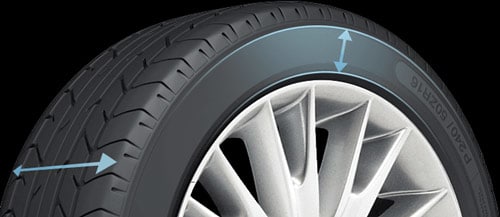Just like history buffs want to read up on everything they can about the Civil War and World War II, car enthusiasts similarly want to know all the ins and outs of every part of the vehicles they love and admire.
Since tires are literally the foundation of every car, they’re a great place to start your education. Plus, there’s actually a lot to learn about this seemingly uncomplicated car part. Here is an overview of everything you need to know about your car’s tires.
1. Basic Terminology
Start your tire tutelage by learning some of the basic tire-related terms.
- Aspect ratio: The aspect ratio is the relationship between the width of a tire and the height of the tire’s sidewall. In particular, the aspect ratio affects the handling and smoothness of your car. Having a low aspect ratio means you’ll experience better handling, but a harsher ride, while a higher ratio tire provides a smoother ride.
- Speed rating: The speed rating is imprinted on a tire’s sidewall and represents the highest speed a tire can safely handle. For example, a V speed rating is for speeds up to 149 mph.
- Load index: The load index indicates how much weight a tire can safely handle. For example, a tire with a load index of 89 is able to handle up to 1,279 pounds.
2. Types of Tires
While there are many different types of tires on the open road, here are the three most common and a bit of information on what they do.
- All-season tires: The all-season tire tends to be the most common and popular on the road, as it’s well-suited to handle most road and weather conditions, except during snow or ice storms. Retailers offer a variety of all-season tires, such as performance all-season, which give up snow traction and tread life for better grip; and touring all-season tires, which provide a more comfortable ride.
- Winter tires: Winter tires (or snow tires) are intended for low temperatures and icy or snowy weather conditions. But they’re not intended for year-round use, as they don’t perform at their best and will wear very quickly during the hot summer months.
- All-terrain tires: All-terrain tires are built to handle both paved roadways and light-to-moderate graded off-road terrain. One drawback, however, is that all-terrain tires have a lower fuel economy and make for a louder ride.
3. Tread Depth
Tread depth is one of the most important safety features to consider when buying new tires. The more worn your tire tread, the more difficult it will be for your car to come to a complete stop. For most new tires, the tread depth is about 10/32nds of an inch.
However, a tire is considered bald and illegal to drive on in many states once it reaches 2/32nds of an inch. To test the tread depth, use either a tread depth gauge or the “penny test.” Simply insert a penny into the tire’s tread, with Lincoln’s head facing down. If you can see the top of Lincoln’s head, your tires are a 2/32nds of an inch and in need of replacement.
4. Proper Inflation
Keeping your tires properly inflated is important to the safety and comfort of your ride. Additionally, properly inflated tires can maximize their lifespan and help increase your car’s fuel efficiency. Newer cars list the recommended tire pressure in your owner’s manual or on the driver-side door jamb.
This number represents the pounds per square inch (psi) when the tires are cool. However, as the tires warm up when motorists drive on hot asphalt, the overall tire pressure will rise a few psi. Note that the psi found on the sidewall of your tire is not the recommended tire pressure, but rather the maximum pressure a tire can handle while under the maximum load.
Understanding basic tire terminology, common types of tires and important tire care like tread depth and inflation are important to give any car enthusiast the basis for understanding their tires, and in turn, their car as a whole.


